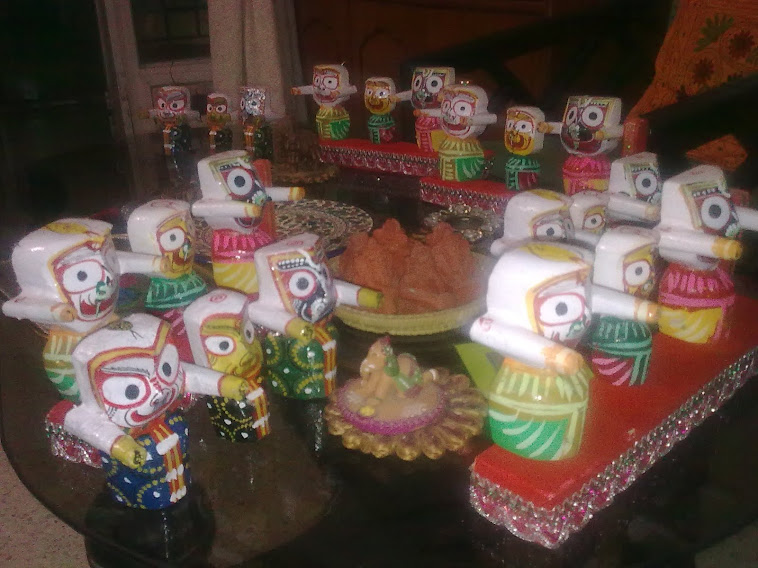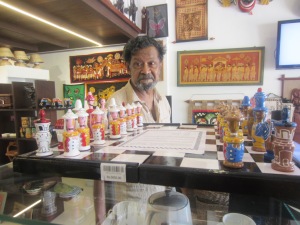Further to my interview with author Ru Freeman, my review of her novel, 'On Sal Mal Lane' has been published in Deccan Herald
 This beautifully-crafted and memorable tale set in Sri Lanka in the 1980s is both heartwarming and heartbreaking.
This beautifully-crafted and memorable tale set in Sri Lanka in the 1980s is both heartwarming and heartbreaking.
Ru Freeman’s gentle, lyrical prose brings to life a gracious past, where ethnic strife casts ominous shadows over a calm neighbourhood and its innocent children.


The author portrays their terrible effects on innocent children and well-meaning adults, as the residents of Sal Mal Lane stand bewildered and helpless before a tsunami of violence.
The cultured and prosperous Herath family, particularly the four children, are at the heart of this story.
The Heraths are Sinhalese Buddhists, who respect all religions. Mrs Herath sings carols during Christmas, and shares the festivities of her neighbours from other religions.
They are generous people who assimilate even the shabby Bolling twins and the dim-witted Raju into their welcoming fold. The Heraths’ lives are filled with music, which enthrals Suren, the eldest son.
Rashmi is the perfect Sri Lankan daughter, with her impeccable behaviour and top grades at school. Nihil, the younger son, is a budding cricketer who has a way with words.
Devi, the lively youngest daughter, is born on an inauspicious date. Nihil takes it upon himself to protect their darling baby sister from disaster and premature death.
As the narrative builds up, we are shown how violence is taking over a peaceful land, and spilling into the lives of the people of Sal Mal Lane.
At times, the ominous build up of the Tamil separatist movement is deftly crafted into the story.
Raju, his mother Mrs Joseph, and their neighbour Mrs Silva discuss how Sinhalese hooligans burnt down the Jaffna Public Library, with its store of priceless manuscripts, and how Prabhakaran, claiming leadership over all Tamils, is leading them into a war against the state.
What matters to these neighbours meeting for a chat is the here and now.
“Only situation for us to worry about is trouble brewing in the North,” says Mrs Joseph.
“Soon, I’m told, it will all come spilling here, to Colombo. To our streets too!” At another point, old Mr Niles reflects how “the matter of language, not of street signs but of education and examination, had been manipulated by both Tamils and Sinhalese in turn, the one alongside the British colonisers, the other after the colonial power had been driven out.”
At times, the exposition can get prolonged and tedious.
The characters come across as mere mouthpieces explaining communal tensions.
From pages 190 to 199, we get dialogues which seem contrived to offer an account of how “Vellupillai Prabhakaran, who was leading a terrorist outfit from the jungles of Jaffna.
Prabhakaran is Tamil, Prabhakaran’s group is Tamil, but not all Tamils support Prabhakaran.
” The riots and its effects on Sal Mal Lane are beautifully rendered, showing the human cost of strife. Violent death visits the lane, ironically caused by the residents themselves.
The book ends on a sad yet hopeful note.
The people of Sal Mal Lane are scarred forever. Yet each character, no matter how insignificant or apparently vile, shows some saving graces.
Sonna Bolling, the ruffian ‘bad boy’, does his best to limit the destruction in his neighbourhood.
 This beautifully-crafted and memorable tale set in Sri Lanka in the 1980s is both heartwarming and heartbreaking.
This beautifully-crafted and memorable tale set in Sri Lanka in the 1980s is both heartwarming and heartbreaking. Ru Freeman’s gentle, lyrical prose brings to life a gracious past, where ethnic strife casts ominous shadows over a calm neighbourhood and its innocent children.
Sal Mal Lane, a dead-end street in Colombo, is a microcosm of Sri Lanka’s multicultural society.
The residents represent all ethnicities and walks of life, from the broad-minded and generous Herath family to poverty-stricken elders Lucas and Alice.
The residents represent all ethnicities and walks of life, from the broad-minded and generous Herath family to poverty-stricken elders Lucas and Alice.
The Bollings exemplify promising lives gone to seed. Their son Sonna’s spirit is mangled with abuse.
The Nadesans and Bin Ahmeds are cultured and reserved, yet gracious and accepting, while the Silvas are prejudiced hardliners.
As the omniscient narrator sums up; “Everyone who lived on Sal Mal Lane was implicated in what happened, including Lucas and Alice, who had no last names nor professed religious affiliations, the Tamil Catholics and Hindus, the Burgher Catholics, the Muslims, and the Sinhalese, both Catholic and Buddhist. Their lives were unfolding against a backdrop of conflict that would span decades involving intermarriage, national language policies, births, deaths, marriages, and affairs — never divorces — subletting, cricket matches, water cuts, power outages, curfews, riots, and the occasional bomb. And while this story is about small people, we must consider the fact that their history is long and accord them, too, a story equal to their past.”
The Nadesans and Bin Ahmeds are cultured and reserved, yet gracious and accepting, while the Silvas are prejudiced hardliners.
As the omniscient narrator sums up; “Everyone who lived on Sal Mal Lane was implicated in what happened, including Lucas and Alice, who had no last names nor professed religious affiliations, the Tamil Catholics and Hindus, the Burgher Catholics, the Muslims, and the Sinhalese, both Catholic and Buddhist. Their lives were unfolding against a backdrop of conflict that would span decades involving intermarriage, national language policies, births, deaths, marriages, and affairs — never divorces — subletting, cricket matches, water cuts, power outages, curfews, riots, and the occasional bomb. And while this story is about small people, we must consider the fact that their history is long and accord them, too, a story equal to their past.”
The author portrays with tender empathy how good intentions can result in warped and terrible outcomes.
Cruelty, intended and unintended, to one person, can cause a chain of unforeseen and apparently unconnected disasters.
Kindness can also come from unexpected places to usher in rays of hope. The significance of impersonal news reports of terror attacks, upheavals and the machinations of political leaders, finally reaches Sal Mal Lane.
Cruelty, intended and unintended, to one person, can cause a chain of unforeseen and apparently unconnected disasters.
Kindness can also come from unexpected places to usher in rays of hope. The significance of impersonal news reports of terror attacks, upheavals and the machinations of political leaders, finally reaches Sal Mal Lane.
The author portrays their terrible effects on innocent children and well-meaning adults, as the residents of Sal Mal Lane stand bewildered and helpless before a tsunami of violence.
The cultured and prosperous Herath family, particularly the four children, are at the heart of this story.
The Heraths are Sinhalese Buddhists, who respect all religions. Mrs Herath sings carols during Christmas, and shares the festivities of her neighbours from other religions.
They are generous people who assimilate even the shabby Bolling twins and the dim-witted Raju into their welcoming fold. The Heraths’ lives are filled with music, which enthrals Suren, the eldest son.
Rashmi is the perfect Sri Lankan daughter, with her impeccable behaviour and top grades at school. Nihil, the younger son, is a budding cricketer who has a way with words.
Devi, the lively youngest daughter, is born on an inauspicious date. Nihil takes it upon himself to protect their darling baby sister from disaster and premature death.
As the narrative builds up, we are shown how violence is taking over a peaceful land, and spilling into the lives of the people of Sal Mal Lane.
At times, the ominous build up of the Tamil separatist movement is deftly crafted into the story.
Raju, his mother Mrs Joseph, and their neighbour Mrs Silva discuss how Sinhalese hooligans burnt down the Jaffna Public Library, with its store of priceless manuscripts, and how Prabhakaran, claiming leadership over all Tamils, is leading them into a war against the state.
What matters to these neighbours meeting for a chat is the here and now.
“Only situation for us to worry about is trouble brewing in the North,” says Mrs Joseph.
“Soon, I’m told, it will all come spilling here, to Colombo. To our streets too!” At another point, old Mr Niles reflects how “the matter of language, not of street signs but of education and examination, had been manipulated by both Tamils and Sinhalese in turn, the one alongside the British colonisers, the other after the colonial power had been driven out.”
At times, the exposition can get prolonged and tedious.
The characters come across as mere mouthpieces explaining communal tensions.
From pages 190 to 199, we get dialogues which seem contrived to offer an account of how “Vellupillai Prabhakaran, who was leading a terrorist outfit from the jungles of Jaffna.
Prabhakaran is Tamil, Prabhakaran’s group is Tamil, but not all Tamils support Prabhakaran.
” The riots and its effects on Sal Mal Lane are beautifully rendered, showing the human cost of strife. Violent death visits the lane, ironically caused by the residents themselves.
The book ends on a sad yet hopeful note.
The people of Sal Mal Lane are scarred forever. Yet each character, no matter how insignificant or apparently vile, shows some saving graces.
Sonna Bolling, the ruffian ‘bad boy’, does his best to limit the destruction in his neighbourhood.
Jimmy Bolling, the insensitive and cruel father, goes forth to help his neighbours in distress.
The neighbourhood shopkeeper refuses payment for food intended for riot victims. Even the bigoted Silvas leave buckets on the road, for neighbours to douse fires caused by rioting.
The children are weighed down by the knowledge that what has been lost can never be regained.
Yet there is life beyond the ashes of arson, looting and death.
Suren continues to seek solace in music, while Rashmi immerses herself in cooking delicacies Devi loved, and then sharing the treats with others less privileged.
The neighbourhood shopkeeper refuses payment for food intended for riot victims. Even the bigoted Silvas leave buckets on the road, for neighbours to douse fires caused by rioting.
The children are weighed down by the knowledge that what has been lost can never be regained.
Yet there is life beyond the ashes of arson, looting and death.
Suren continues to seek solace in music, while Rashmi immerses herself in cooking delicacies Devi loved, and then sharing the treats with others less privileged.
Nihil learns to put behind his resentment, emerges from his self-created cocoon of isolation, and reaches out again to Mr Niles.
On Sal Mal Lane
Ru Freeman
Penguin
2013,
pp 388
Rs 499
Ru Freeman
Penguin
2013,
pp 388
Rs 499




